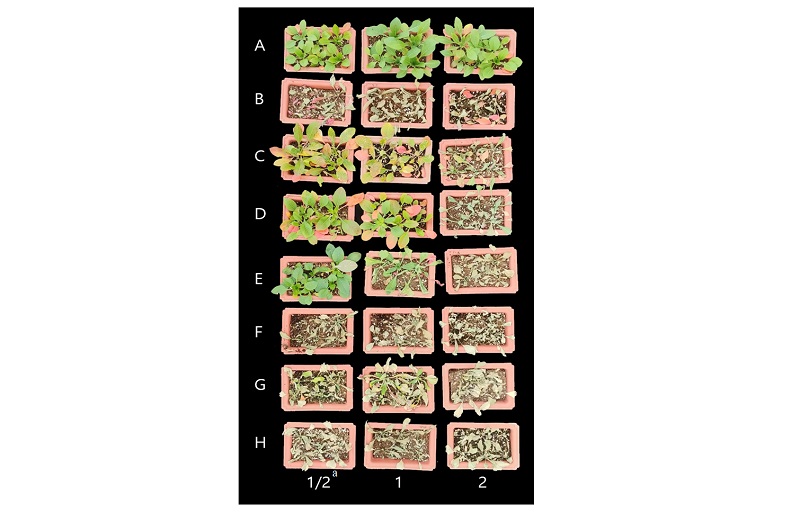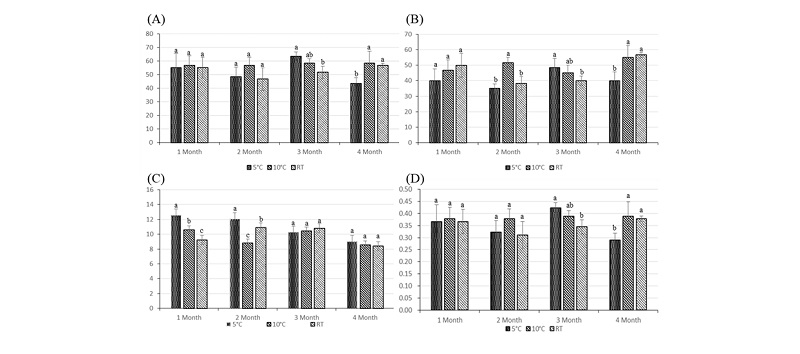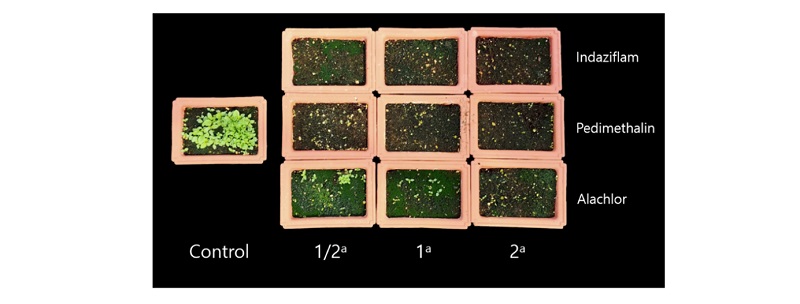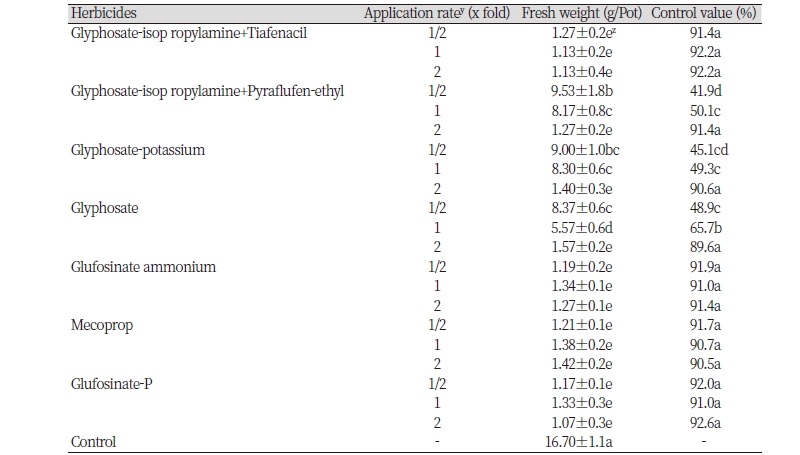Introduction
Recently, interest has been growing on the ecological effects, aspects of climate change, and management of exotic plants (Bai, 2014; Mack et al., 2000; Pimentel et al., 2000).
As the industrial development increases due to international exchange, the exotic plants are repeatedly expanded or disappear every year, and interrupting both ecosystem and economic. Exotic species are often a major problem for both domestic and foreign ecosystem (Lim et al., 2009). The exotic plant is mainly introduced into the ecosystem by unintentional incorporation of food and feed grain (Oh et al., 2003) and intentional incorporation for economic use. Among them, ornamental plants used in gardens, parks, roads, etc., are one of the main inflow routes for exotic plants (Katharina et al., 2007).
Exotic plants have a variety of invading pathways compared with native plants and have ecological characteristics such as rapid habitat expansion and extensive habitat adaptation (Gould, 1991; Jordan and Jannink, 1997; Martinez-Ghersa et al., 2000; Mohler, 2001).
Exotic plants have fewer germination conditions and excellent fertility even under harsh environmental conditions than native plants. Also, exotic plants are easier to germinate even in harsh environmental conditions than native plants (Newsome and Noble, 1986), and have more excellent propagation potential (Mooney, 1996), exotic weeds invading the agricultural land quickly and adapt to the environment (Cox, 1993), Compared to general grassland, there is less contention between plants and rich nutrients in agricultural land, so if there is no proper weed control, it is a good place for propagation of exotic weeds (Kim et al., 2016; Koh et al., 2002). The diffusion of exotic weeds in agricultural land has continued since exotic weeds have been introduced into Korea, and it has been difficult to cultivate and manage crops (Clements et al., 2004).
321 species of exotic plants have been naturalized in South Korea, with the number of 158 annual weed species (49%) and inflowed about 100 species in the last decade at 2009 (Park, 2009). Origin was followed by Europe (134 species, 42%), North America (75 species, 23%), Eurasia (28 species, 9%) and tropical America (27 species, 8%). Currently, they were getting more country of origin tends to diversify (Kim et al., 2000).
Currently in Korea, there are 14 varieties, 38 families, 169 genera, 298 species, 312 taxon as naturalized plants (NKISBS, 2018) These naturalized plants expand in our habitat and ecosystem, threatening native flora and disturbing ecosystems (Lowe et al., 2000; Luken and Thieret, 1997), Some species, such as Common ragweed (Ambrosia artemisiifolia L.), contain allergens in pollen, which is a serious injury (Kim and Oh, 2009). Giant ragweed (Ambrosia trifida L.) and Common ragweed (Ambrosia artemisiifolia L.) is predominant in nutrient and photosynthesis due to rapid growth (Cowbrough et al., 2003; Webster et al., 1994) and secretion of allelochemical substance (Choi et al., 2010; Kong et al., 2007; Vidotto et al., 2013) inhibits the growth of surrounding plants and unification of surrounding vegetation.
The introduction of Iris pseudoacorus L. in wild wetlands (Kim and Lee, 2013) has been reported to affect biodiversity maintenance as an example of a green wash (Primack, 2002). Moreover, the invasion of exotic plants in the domestic ecosystem cannot be despised yet, and proper management and research on exotic plants are needed. In Korea, the management of exotic plants is carried out with a large amount of budget every year, but the effect is not clear compared to the input cost. In the case of foreign countries, invading exotic plants that are spread widely are not easy to manage.
Among naturalized plants, evening primrose (Oenothera biennis) is a biennial plant belonging to Onagraceae family and is considered as a weed of hayfields and meadow. O. biennis has been reported for posing an annual conditional dormancy-nanodormancy cycle and remain viable for more than 40 years in soil (Qaderi et al., 2015). It is presumed to have flowed after the opening of the port, and roots and seeds are used for medicinal purposes, however, high rate of seed production and germination its distributed all over the country, affecting the domestic ecosystem with rapid habitat diffusion rate (Kim et al., 2015). Recently, it has been rapidly invading and spreading in the sand dune ecosystem, disturbing the ecosystem (Kim et al., 2015). In the field of Angelica gigas, weed was reduced by 49.6% in total yield, and biennial weeds (including evening primrose weeds) accounted for 26.7% of 28 species out of 105 species (Lee et al., 2016). However, there is a lack of studies on the management of O. biennis that has spread nationwide yet. Likewise, in order to effectively manage rapidly spreading weeds, we need to know how weeds occur first (Lee et al., 2017).
This study was conducted to investigate the effects of various environmental conditions including temperature, light conditions, and seedling depth as well as pesticides on the germination of the O. biennis and to select suitable herbicides for pre-emergence and post-emergence O. biennis control.
Materials and Methods
The seeds of evening primrose (Oenothera biennis) used in this experiment were collected at Gaholi, Bugye-myeon, Gunwi-gun and Gyeongsangbuk-do (GIS 36o 05 29" N, 128o 39 56" E ) in October 2017 and stored in a refrigerator at 4℃ until germination study.
Germination and early growth study
Effect of light condition on germination and early growth of O. biennis
To determine the characteristics of seed germination by different light conditions (light, dark), one filter paper was placed in a disposable sterile petri-dish (58×17 mm), and 20 seeds were sowed on it and then sealed. The temperature during the experiment period was maintained at 25±2℃, 1.5 mL of distilled water was supplied on the first day of Sowing to aviode the dryness and maintained the moisture. The germination percentage at 3, 5, 10, 15, 20, and 25 days after sowing and leaf number and plant height after 30 days of sowing were investigated. The germination was regarded as having a radicle of 2 mm or more.
Effect of temperature condition on germination and early growth of O. biennis
To determine the characteristics of seed germination by different temperature conditions (5, 15, 25, 35℃), 20 seeds were sowed in a disposable sterile petri-dish (58×17 mm) haveing one filter paper, and placed it in the incubator (BF-50SIR, BioFREE, Seoul, Korea) to investigate the germination rate at different tempartures. Moreover, 1.5 mL of distilled water was supplied on the first day of Sowing, moisture was maintained to not to dry. The germination percentage at 3, 5, 10, 15, 20 days after sowing and fresh weight and plant height after 20 days of sowing were investigated.
Effect of seeding depth on germination and early growth of O. biennis
To determine the characteristics of seed germination by different seeding depth, 30 seeds were seeded in a pot (100 mm×90 mm) filled with bed soil in a greenhouse, which maintained at 30±5℃. Seeding depths were 0, 1, 2, 3, 4, 5, and 6 cm. The germination percentage at 5, 10, 15, 20, 30, and 40 days after seeding and shoot fresh weight and hypocotyle length after 60 days of seeding were investigated.
Effect of seed storage temperature on germination and early growth of O. biennis
To determine the characteristics of seed germination by different storage temperature and period condition, plants were harvested, cleaning and stored at 5℃, 10℃, and room temperature for 4 months. The germination percentage, Germination energy, Mean germination time, Mean daily germination and water contents were investigated for 4 months at 1 month intervals. Water contents were measured by drying 4 g of seeds in schale (95 mm×15 mm) at 120℃ for 2 hours (ISTA, 2007).
Selection of herbicides for chemical O. biennis control
For control of O. biennis, herbicides are the most effective method. Herbicides can be used either before seeding emergence (pre-emergence) or after seeding emergence (post-emergence).
Currently, there are no herbicides for evening primrose (O. biennis) control in Korea. Therefore, to select herbicides for pre-emergence control and post-emergence control, various herbicides with different modes of action were tested (Table 1).
Selection of herbicides for pre-emergence control
The selection of soil applied herbicides effective to O. biennis, 100 seeds were seeded in the plastic pot (16.5 cm×12 cm×6 cm) and covered with soil about 0.5 cm.
Three days after sowing, the pots were treated by using different herbicides (Table 1) through the foliar application, after 4 weeks of herbicides application the fresh weight of treated and control plants were scrutinized.
All the herbicides were purchased from the market. The generic names and trade names of the herbicides are as follows. Alachlor (Lasso®, Farm Hannong, Seoul, Korea), Pedimethalin (Stomph®, Farm Hannong), Indaziflam (Allion®, Bayer Korea, Seoul, Korea). The experiment was carried out in a complete randomized design with three replications.
Selection of herbicides for post-emergence control
The selection of foliar applied herbicides that are effective to O. biennis the seeds were germinated in plastic-tray (200 pots), after 20 days from germination, six equal sized seedlings were selected and transplantaion to the plastic pots (16.5 cm×12 cm×6 cm). 30 days after transplantation, foliar application of seven herbicides (Table 1) were spayed with recommended volume as mentioned in table 1. After 10 days, fresh weight and control value efficacy were investigated. All the herbicides were purchased from the market. The generic names and trade names of the herbicides are as follows. Glyphosate-isopropylamine+Tiafenacil (Teradoplus®, Farm Hannong), Glyphosate-isopropylamine+Pyraflufen-ethyl (Newpulmagi®, Farm Hannong), Glyphosate-potassium (TouchdownIQ®, Syngenta Korea, Seoul, Korea), Glyphosate (Guensami®, Farm Hannong), Glufosinate -ammonium (Basta®, Bayer Korea), Mecoprop(YoungilMCPP®, Nonghyup Chemical, Seongnam, Korea), Glufosinate-P (Jakusa®, Hankooksamgong, Seoul, Korea). The experiment was carried out in a complete randomized design with three replications.
Results and Discussion
Germination and early growth of O. biennis influenced by light condition.
As a result of germination and early growth of O. biennis influenced by light condition (light, dark), O. biennis has the ability to germinate in both light and dark conditions, although its germination was delayed and decreased under dark condition and as the period elapsed the plants germinated in dark conditions died (Fig. 1). These results suggest that for these exotic plants germination light is necessary. The number of leaves of O. biennis was 3.6 EA in light condition and 1.8EA in dark condition at 30 days after seeding (DAS) (Table 2). Also, the plant height in the dark condition was about 3 times longer than in light condition (Table 2), This is generally the same pattern that plants are reported to have a longer plant height as the shading rate increases (Moon and Pyo, 1981; Oh et al., 2015).
|
Table 2. Germination and early growth of O. biennis under light and dark condition. 
|
|
|
y DAS: Days after seeding. z Mean separation within columns by Duncan's multiple range test at P=0.05. |
|
Germination and Early Growth of O. biennis Influenced by Air Tempertature.
Impacts of different temperature conditions (5, 15, 25, and 35℃) on germination characteristics of O. biennis illustrated that highest germination percentage (55%) was exhibited at 25℃ and plant height and shoot fresh weight were recorded significantly higher than other treatments. At 5℃ and 15℃ treatment, germination was not observed, it suggests that the germination percentage decreased at low temperature. At 25℃ and 35℃ treatment, germination percentage was 55% and 35%, respectively, but plant height and shoot fresh weight shows no significant difference between these two treatments (Table 3, Fig. 2).
|
Table 3. Germination and early growth of O. biennis under different air temperatures. 
|
|
|
y DAS: Days after seeding. z Mean separation within columns by Duncan's multiple range test at P=0.05. |
|
Germination and early growth of O. biennis influenced by seeding depth
As a result of germination characteristics of O. biennis by different seeding depth condition, it was not emergence on the soil surface when seeding depth was over 4 cm (Fig. 3). However, germination under the soil was observed even at a seeding depth of 4 cm or more, but it was confirmed that the plant died before reaching the soil surface. At seeding depth 0 cm and 1 cm, germination percentage was maintained at 61% and 51%, respectively, over all it was recorded 50%, while at seeding depth 3cm, germination percentage significantly decreased upto 30% (Table 4).
|
Table 4. Germination and early growth of O. biennis under differnet seeding depths. 
|
|
|
y DAS: Days after seeding. z Mean separation within columns by Duncan's multiple range test at P=0.05. |
|
The hypocotyle has started to occur from Seeding depth 1 cm, which was increased depending on Seeding depth (Fig. 3). There were significant decreases in shoot fresh weight with the seeding depth, these observations demonstrate that shoot fresh weight related to the emergence rate on the ground. This is the same pattern that winter wheat is reported to Seeding depth in relation to plant development and emergence rate (Loeppky et al., 1989).
Germination of O. biennis influenced by storage temperature
As a result of germination characteristics and water contents of O. biennis by different storage temperature and period conditions. Seeds treated with 5℃ for 4 months shows significant variation compared to 10℃ and RT, as the period increased the water content, germination percentage, germination energy, average germination time, mean daily germination was significantly enhanced (Fig. 4). After storage for 4 months at 5℃, the lowest germination percentage was observied (43%) and germination energy (40%) (Fig. 4). In comparison with storage at 5, 10℃ and room temperature, the storage at 5℃ exhibited the had the highest mean germination time and displayed lowest mean daily germination (Fig. 4). It means storage at 5℃ is later germination than others. The water contents in the seeds are related to the seed viability during storage, decreases, parallel and increases with storage month. This is a phenomenon occurring during the seed deterioration process (Na et al., 2013)
Herbicides for pre-emergence O. biennis control
As a result of investigating the effect of soil applied herbicide of O. biennis, Pedimethalin and Indaziflam treatments showed 99 % control values at all concentrations. The control values of Alachlor half of Recommended rate and Recommended rate were 92% and 96%, respectively, and 4-6% lower than the other treatments (Table 5, Fig. 5). Alachlor is an herbicide from the chloroacetanilide. The greatest use of alachlor is for control of annual grasses and broadleaf weeds. Its mode of action is elongate inhibition, and inhibition of geranylgeranyl pyro-phosphate (GGPP) cyclisation enzymes, part of the gibberellin pathway.
However, the control values were higher than 90% at all type and concentrations of soil applied herbicide, confirming that the soil applied herbicide was effective in controlling on O. biennis.
Herbicides for post-emergence O. biennis control
The control value of foliar applied herbicide was more than 90% in all the concentrations treatments of Glyphosate-isopropylamine + Tiafenacil, Glufosinate ammonium, Mecoprop and Glufosinate-P among 7 kinds of foliar applied herbicide (Table 6, Fig. 6).

Fig. 6. Post-emergence control of O. biennis by foliar-applied post-emergence herbicides (a: Ratio to the recommended dose rate, A: control, B: Glyphosate-isopropylamine+Tiafenacil, C: Glyphosate-isopropylamine+Pyraflufen-ethyl, D: Glyphosate-potassium, E: Glyphosate, F: Glufosinate ammonium, G: Mecoprop, H: Glufosinate-P, 10 days after treatment).
Glyphosate is a organophosphate herbicide and has been used for control of perennial weeds. Glyphosate-isopropylamine+Pyraflufen-ethyl of 1/2 recommended rate and full recommended rate showed only 42, 50% O. biennis control, respectively. Glyphosate-potassium of 1/2 recommended rate and full recommended rate showed 45% and 49%, respectively.Glyphosate of 1/2 recommended rate and full recommended rate showed 48% and 65% respectively. The organophosphate treatment showed about 30-50% less control value than the other treatments. Interestingly, the mixture of organophosphate and uracil compounds (Glyphosate-isopropylamine+Tiafenacil) showed over 90% control even at its 1/2 recommended rate. This is probably due to the effect of Tiafenacil. Therefore, the mixture treatment of glyphosate and tiafenacil is highly recommended for post-emergence O. biennis control.
Acknowledgement
This study was supported by the Agenda Program (Project No. PJ013216032018) Rural Development Administration, Republic of Korea.Authors Information
Jeung-Woo Ko, Division of Plant Biosciences, Kyungpook National University, Master student
Yu-Na Kim, Division of Plant Biosciences, Kyungpook National University, Master student
Seon-Min Park, Division of Plant Biosciences, Kyungpook National University, Master student
Chang-Wook Park, Division of Plant Biosciences, Kyungpook National University, Master student
Hee-Soon Park, Division of Plant Biosciences, Kyungpook National University, Master student
Yeon-Gyeong Park, Division of Plant Biosciences, Kyungpook National University, Ph.D. student
Ko-Eun Lee, Division of Plant Biosciences, Kyungpook National University, Ph.D. student
In-Yong Lee, Division of Plant Biosciences, Kyungpook National University, Researcher
In-Jung Lee, Division of Plant Biosciences, Kyungpook National University, Professor










